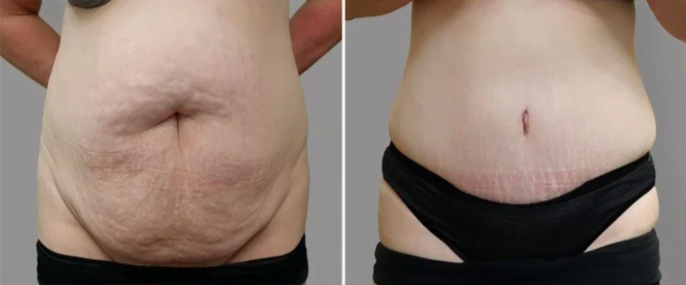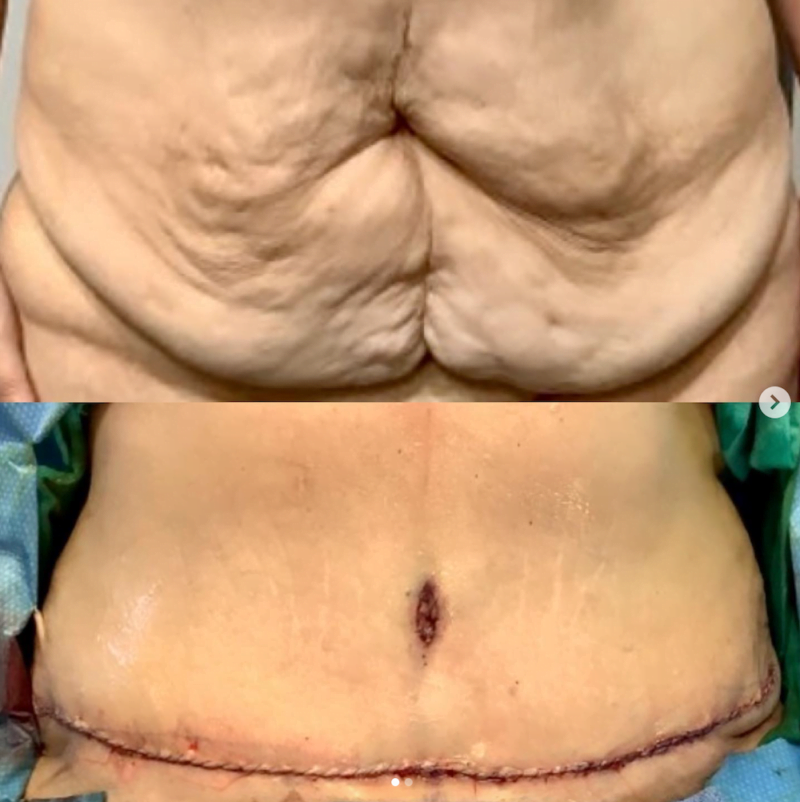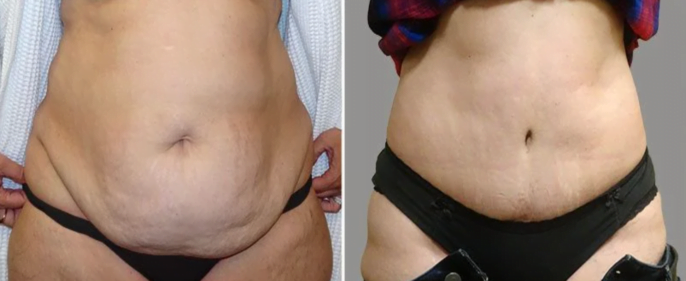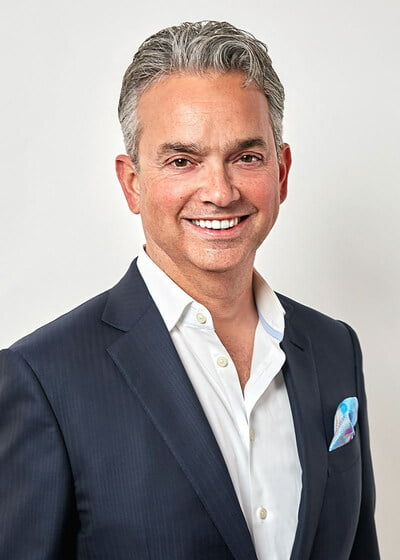Tummy Tuck Hagerstown (Abdominoplasty)
Maryland tummy tuck surgeon Dr. Henry Garazo offers terrific tummy tuck results to his patients at Plastic Surgery Services in Hagerstown. For some men and especially for women, no amount of diet and exercise can achieve the flat abdomen they want. Factors such as pregnancy, genetics, weight fluctuation, and age can produce lax abdominal skin, stubborn fat pockets, and stretched abdominal muscles that mar their appearance.
Abdominoplasty (also known as a tummy tuck) can address these abdominal issues, while creating the firm, flat stomach you seek.

What is a tummy tuck?
A tummy tuck is a highly personalized surgical procedure Dr. Garazo uses to sculpt a flatter and more toned abdomen. By removing excess skin and fat from the abdomen and tightening your abdominal muscles, Dr. Garazo can offer an improved abdominal profile you will be proud to show off. Depending upon the extent of the issues you want to address, Dr. Garazo will recommend the ideal tummy tuck technique for you. There are three main types of tummy tuck surgeries:
- Full tummy tuck: A full or standard tummy can remove a significant amount of skin and fat and tightening the muscles across the entire abdominal wall. This techniques uses two incisions, a horizontal incision between the hip bones and around the navel.
- Mini tummy tuck: A mini tummy tuck focuses on the area below the navel and involves a shorter incision just above the pubic area.
- Extended tummy tuck: An extended tummy tuck is a lesser used technique but may be ideal for patients with excess skin and fat that extends around the hips (flanks) and lower back. This technique uses a longer incision that wraps around the hips and an incision at the navel.
Full vs. mini tummy tuck
Patients often wonder which tummy tuck technique they’ll need: a full tummy tuck addresses excess skin and fat on both your upper and lower abdomen, can correct abdominal muscle separation (diastasis recti), and can reshape and reposition the belly button. A mini tummy tuck is slightly less invasive and offers improvement to your lower abdomen only. A mini tummy tuck doesn’t typically address muscle separation or the belly button’s shape or position, so it’s best for patients who only need moderate adjustments to the lower tummy area. Dr. Garazo uses the full tummy tuck technique for most patients.

View our abdominoplasty before and after gallery »
Am I a good candidate for tummy tuck surgery?
During your tummy tuck consultation, you will meet one-on-one with Dr. Garazo, where he will discuss your goals and assess whether you are a good candidate for the procedure. The best candidates for an abdominoplasty include men and women who are unhappy with their abdominal profile. Indications for tummy tuck surgery include:
- Excess skin and fat in the abdominal area that doesn’t respond to diet and exercise.
- Weakened or separated abdominal muscles due to pregnancy, weight fluctuations, or aging.
Good candidates are also healthy non-smokers with realistic expectations about the results they seek. Although abdominoplasty can offer great improvement to post-pregnancy bellies, women planning future pregnancies should postpone their procedure, since the next pregnancy can mar the results. It is also suggested patients be as close to their ideal weight as possible when undergoing the procedure.
“Dr. Garazo and his team couldn’t have been more professional, kind and dedicated. Their professionalism blew me out of the water and their knowledge outweighed my expectations. I felt comfortable as I went through the surgery and recovery process.”
—Real patient of Dr. Garazo | View more testimonials
Preparing for tummy tuck surgery
Because tummy tucks are a surgical procedure, a significant part of the preparation is learning about the procedure and what the recovery period will entail.
Leading up to your tummy tuck
Before your tummy tuck procedure, you will need to do the following to prepare:
- Stop smoking. Smoking can slow the healing process and also increases the risk of tissue damage. If you smoke, Dr. Garazo will recommend that you stop smoking before surgery and throughout your recovery.
- Avoid blood-thinning medications. Dr. Garazo asks his tummy tuck patients to please refrain from taking certain blood-thinning medications such as aspirin, for two weeks before surgery. Click here to see a full list of medications to avoid.
- Plan to have help during recovery. Arrange for a ride home after you leave the hospital, and for someone to stay with you for at least the first night of your recovery.
We encourage our patents to read up on the procedure, so they will know what to expect before, during, and following their surgery. We have a number of forms with helpful info in the patient resources section of the site. Check out our body contouring blog for fun, educational posts about tummy tucks and other surgical and non-surgical procedures.
Popular posts about tummy tucks:
- Will a Tummy Tuck Give Me an Hourglass Figure?
- Here’s How to Get Rid of Belly Fat Once and For All
- Key Benefits
- Glossary
- Flatter, More Toned Abdomen: A tummy tuck removes excess skin and fat and tightens the abdominal muscles, resulting in a flatter and more toned stomach.
- Reduced Appearance of Stretch Marks: By removing skin from the lower abdomen, a tummy tuck can also reduce the number of visible stretch marks in this area.
- Enhanced Core Strength and Stability: Tightening the abdominal muscles can improve core strength and stability, potentially alleviating lower back pain and improving posture.
- Correction of Ventral Hernias: A tummy tuck can also repair ventral hernias by restoring weakened or separated muscles to their original condition, preventing hernia recurrence.
- Abdominoplasty: The medical term for a tummy tuck, a cosmetic surgical procedure that removes excess skin and fat from the abdomen and tightens the abdominal muscles.
- Anesthesia: Medication administered to prevent pain during surgery; tummy tuck procedures typically require general anesthesia.
- Compression Garments: Specialized clothing worn after surgery to minimize swelling, support the healing tissues, and help the skin conform to the new body contours.
- Diastasis Recti: A condition characterized by the separation of the left and right side of the rectus abdominis muscle, which can be corrected during a tummy tuck.
- Drainage Tubes: Temporary tubes that may be placed under the skin to drain excess fluid from the surgical site, helping to reduce swelling and prevent complications.
- Extended Tummy Tuck: A more comprehensive version of the traditional tummy tuck that includes the removal of excess skin and fat from the abdomen as well as the flanks and lower back, resulting in a longer scar.
- Liposuction: A surgical procedure that removes fat from specific areas of the body using a suction technique, which can be performed alongside a tummy tuck for enhanced body contouring.
- Mini-Abdominoplasty: A less invasive version of the traditional tummy tuck that focuses on removing excess skin and fat from the lower abdomen with a shorter incision and without tightening the abdominal muscles.
- Panniculectomy: A surgical procedure that removes only the excess skin and fat hanging over the genitals and thighs, often considered for medical reasons rather than cosmetic.
- Recovery Period: The time required for healing after a tummy tuck, during which activities are limited based on the surgeon’s recommendations to ensure optimal healing.
- Scar: The line or pattern left on the skin after surgery. Tummy tuck scars are typically located along the lower abdomen but can vary based on the extent of the procedure and the specific technique used.
- Skin Excision: The surgical removal of loose, excess skin, which is a primary component of the tummy tuck procedure.
- Stretch Marks: Streaks or lines that appear on the skin due to rapid stretching, often from pregnancy or weight gain; a tummy tuck may remove or reduce stretch marks located on the excised skin.
- Tightening of Abdominal Muscles: A key part of the tummy tuck procedure that involves suturing stretched or separated abdominal muscles back together to create a firmer abdomen.
- Truncal Contouring: A term that refers to the shaping and sculpting of the abdominal area to achieve a more aesthetically pleasing body contour, often part of a tummy tuck.

What happens during tummy tuck surgery?
All surgical procedures are performed by Dr. Garazo on our on-site, state of the art surgical suite, The Galleria Surgery Center. The Quad-A accredited facility offers a pristine environment, advanced technology, and the highest standards of patient care and safety. The Galleria Surgery Center is a fully-equipped outpatient surgical suite with a dedicated team of certified and experienced physicians, anesthesia providers, and recovery room staff.
Anesthesia
Dr. Garazo performs tummy tuck surgery under general anesthesia for your safety and comfort. This means you will be asleep during surgeon and feel no pain during surgery. A board certified anesthesiologist or board certified registered nurse anesthetist (CRNA) will provide all anesthesia services, ensuring you are safe and cared for throughout the entirety of your surgery.
Procedure
During the surgery, Dr. Garazo will carefully make incisions based on the tummy tuck technique that will best suit your needs to remove the excess skin and fat in your abdominal area. Then, the connective tissue that lies over the abdominal muscles will be tightened with sutures to really cinch the waist and give that desired hourglass shape. If you have muscle separation, Dr. Garazo will repair those as well. Depending on the extent of your procedure, tummy tuck surgery can take anywhere from one to five hours.
Tummy tuck recovery
Immediately following your tummy tuck surgery, your incisions will be covered by dressings and bandages. You will also be wrapped in a tight compression garment to reduce swelling and support your abdomen as it heals. As you recover, it is very important that you follow all post-op instructions, including wearing the garment and caring for your incisions and bandages.
Activity restrictions after tummy tuck surgery
Most patients are advised to avoid strenuous activities for at least 4 to 6 weeks; however, short gentle walks beginning the day after surgery will help keep your blood circulating to promote faster healing. Many patients take off 1-2 weeks from work, depending on their job requirements.
At your follow-up appointments, Dr. Garazo and our outstanding medical staff will monitor your progress and verify you are healing as expected. As your body is ready, Dr. Garazo will also clear your for certain activities.

Tummy tuck results
Because the procedure involves removing excess skin and fat, your new hourglass shape will be instantly noticeable. Any initial swelling from the surgery will subside over time, and surgical scars will continue to fade if properly cared for in the months following surgery.
By 3-6 months, you’ll be near your final results, but you may notice subtle improvements in your shape for up to 12 months are your body continues to resolve swelling and settle into the new silhouette.
Tummy tuck results are long lasting if you maintain a stable weight.
Combining tummy tucks with other procedures
An abdominoplasty can be performed alone, or in conjunction with other procedures for a more complete transformation. Men and women often pair abdominoplasty with liposuction to sculpt a trim physique throughout the abdomen and hips. Women often complement their tummy tucks with a breast augmentation and/or a breast lift for a complete transformation—a customized procedure commonly known as a mommy makeover. Through careful consultation with Dr. Garazo, you can determine whether a tummy tuck alone or a combination of procedures can offer the beautiful body you seek.

View our abdominoplasty before and after gallery »
“Dr. Garazo and the wonderful staff here have changed my life. I went in wanting to fix some damage done to my tummy from 3 C-Sections and was treated with so much respect and care. I was immediately made to feel comfortable and could tell I was in great hands. I’m 4 weeks post surgery now and I’m beyond happy with the result. The medical assistants and nurses did such an amazing job making me comfortable and even taking after hours calls to check in on me. If you’re considering plastic surgery, there is no one I would recommend more than Dr. Garazo and his team!”
—Real patient of Dr. Garazo, February 2023 | View more testimonials
Tummy tuck FAQS
Will I need help at home during my recovery?
Yes, you will need to have someone assist you at home for at least the first few days after surgery, as you will need help with daily activities, managing medications, and ensuring you follow post-operative care instructions. If you have small children at home, you’ll need to plan for childcare as you will not be able to lift anything over 5-10 lbs for at least 4-6 weeks.
Can a tummy tuck help with stretch marks?
Yes! A tummy tuck can remove some stretch marks, particularly those located on the lower abdomen, as the excess skin is excised. However, it is not specifically designed to treat stretch marks so stretch marks around the belly button and on the upper abdomen will not be disturbed.
Will there be scars after a tummy tuck?
Yes, scars are inevitable, but board-certified surgeons like Dr. Garazo are trained to precisely suture incisions so they heal as thin as possible. The primary tummy tuck scar can be easily concealed by a swim suit or underwear, and the incision at the navel will be hidden within your belly button. Following all aftercare instructions, especially the activity restrictions, will help your scar flatten and fade. You’ll also want to make sure you protect the scar from UV light so it doesn’t darken.
Is a tummy tuck a weight loss procedure?
No, a tummy tuck is not a weight loss procedure. It is intended to contour the abdomen and remove excess skin and fat. Patients should be at or near their ideal weight before surgery to see the best results. That said, many patients find exercise more comfortable once extra skin is removed and abdominal muscles are repaired and can function properly.
Can I get pregnant after a tummy tuck?
Yes, you can get pregnant after a tummy tuck, but it is generally recommended that you wait until you have finished having children to prevent future pregnancies from impacting your tummy tuck results.
How long will I need to wear a compression garment after surgery?
Most patients are asked to wear a compression garment for about 4 to 6 weeks after surgery or as otherwise instructed by Dr. Garazo. Compression garments help reduce swelling, support the abdominal muscles, and improve the overall contour of the abdomen during the healing process, so it is very important that you follow Dr. Garazo’s recommendations.
What activities should I avoid during tummy tuck recovery?
During recovery, you should avoid strenuous activities, heavy lifting, and intense exercise for at least 6 to 8 weeks. You’ll also be asked bend slightly at the waist for the first 2 weeks to avoid straining your healing incision. As your body heals, you’ll be able to gradually resume your normal activities with Dr. Garazo’s approval.
Will a tummy tuck affect my belly button?
Yes, unless you undergo a mini tummy tuck. For all other techniques, Dr. Garazo will usually reposition the belly button during a tummy tuck to ensure it remains in a natural position after the excess skin is removed. Depending on the appearance before surgery, the look of your belly button may change slightly or it can reconstructed to appear more natural.

What is the difference between a tummy tuck and liposuction?
A tummy tuck removes excess skin, some fat, and tightens abdominal muscles, while liposuction solely removes fat deposits. Liposuction is often performed in conjunction with a tummy tuck to fine-tune your results and to sculpt other parts of the body to perfect your silhouette.
When can I return to work after a tummy tuck?
Your job requirements will determine how long you need to take off work: most patients can return to a desk job within 1-2 weeks. If your job is more physically demanding, you may need a longer recovery period.
How soon can I drive after a tummy tuck?
We typically advise patients to avoid driving for at least 1 to 2 weeks post-surgery or until they are no longer taking prescription pain medications and feel comfortable moving without pain or restriction.
Can men have tummy tuck surgery?
Yes, men can undergo tummy tuck surgery to address excess abdominal skin and fat, particularly after significant weight loss. Dr. Garazo tailors his technique to achieve a more masculine look, sculpting the midsection to showcase a chiseled physique instead of the feminine curves many female patients request.
Can I sleep on my stomach after a tummy tuck?
Eventually, yes. You’ll need to sleep on your back with their upper body slightly elevated for several weeks after surgery to minimize pressure on the abdomen and aid in the healing process. Once Dr. Garazo gives his OK, you’ll be able to sleep on your stomach again.
Will a tummy tuck improve my posture?
It can; tightening the abdominal muscles and reducing excess skin can improve core strength and support, potentially leading to better posture and reduced lower back pain.
Can I have a tummy tuck if I have had previous abdominal surgery?
Probably; previous abdominal surgery does not automatically disqualify you from having a tummy tuck, but it may affect the procedure’s complexity. Dr. Garazo will evaluate your medical history and discuss any potential challenges during your consultation.
Meet Dr. Henry Garazo

Dr. Garazo is a board-certified plastic surgeon with over 20 years of experience offering aesthetic procedures in the greater Hagerstown, MD area. Known for his thorough, expert, and friendly care, Dr. Garazo is a 6x winner of “Best Plastic Surgeon” in the Herald-Mail Tri-State’s Best Community’s Choice Awards. He prides himself on offering comprehensive, informative consultations and ensures every patient always meets personally with him.
Schedule your tummy tuck consultation today
For those considering a tummy tuck, Frederick plastic surgeon Dr. Henry Garazo invites you to explore your options through a patient consultation. Dr. Garazo has proudly served patients in the greater Maryland area for over 20 years. Named “Best Plastic Surgeon” in the tri-state area by The Herald-Mail’s Community’s Choice Awards for 5 consecutive years, Dr. Garazo specializes in a range of plastic surgery procedures, including breast aesthetics and body contouring.
To schedule a consultation at with Dr. Garazo at his Hagerstown plastic surgery office, contact us online or call (301) 791-1800.
References
American Society of Plastic Surgeons. Tummy Tuck: Abdominoplasty (https://www.plasticsurgery.org/cosmetic-procedures/tummy-tuck). Last reviewed 2022. Accessed 4/11/2024.
The Aesthetic Society. Tummy Tuck (https://www.theaestheticsociety.org/procedures/body/tummy-tuck). Last reviewed 4/28/2020. Accessed 4/11/2024.
Swanson E. Prospective Clinical Study of 551 Cases of Liposuction and Abdominoplasty Performed Individually and in Combination. 2013. Plastic and Reconstructive Surgery Global Open.
Klinger M, Klinger F, Giannasi S, Bandi V, Vinci V, Catania B, Lisa A, Veronesi A, Battistini A, Giaccone M, Caviggioli F, Maione L. Aesthetic and Functional Abdominoplasty: Anatomical and Clinical Classification based on a 12-year Retrospective Study. Plast Reconstr Surg Glob Open. 2021 Dec 20;9(12):e3936. doi: 10.1097/GOX.0000000000003936. PMID: 34938642; PMCID: PMC8687729.
Shermak MA. Abdominoplasty with Combined Surgery. Clinics in Plastic Surgery. 2020 Jul;47(3):365-377. doi: 10.1016/j.cps.2020.02.001.
Matarasso A, Swift RW, Rankin M. Abdominoplasty and abdominal contour surgery: a national plastic surgery survey. Plastic and Reconstructive Surgery. 2006. doi: 10.1097/01.prs.0000209918.55752.f3.
Pollock TA, Pollock H. Progressive tension sutures in abdominoplasty: a review of 597 consecutive cases. Aesthetic Surgery Journal. 2012 Aug;32(6):729-42. doi: 10.1177/1090820X12452294.
